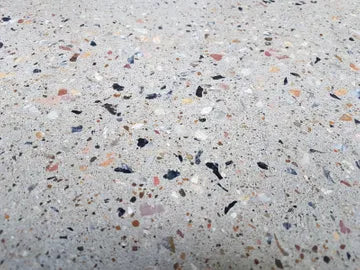POLISHING CONCRETE
Guide to the Procedure
This is a GUIDE to the normal procedure involved in polishing concrete, including exposed aggregate concrete surfaces. The procedure is virtually the same with terrazzo, and other natural stone products.
Note that this is quite different to creating a polish effect by grinding and then coating concrete floors with a clear coating such as epoxy or polyurethane, these use the coating to produce the sheen. To carry out the ‘Cut and Coat’ system you simply follow the same procedure as below, and complete your grinding at the stage prior to Polishing and Hardening Stage.
It has been proven the easiest concrete to grind is a surface that has been ‘broom finished’ as the laitance stands up like fibers and is quickly cut back in comparison to a steel trowelled surface.
You should discuss the finish with your concreter prior to pouring/finishing the concrete. Also the concrete finisher must be aware of the necessity to ensure even distribution of aggregate throughout the surface and that ‘foot prints’ that are filled with slurry, will show through when honed back.
Firstly, a very important word: – no two slabs are the same, even on the one job.
Therefore you:
- Cannot predict what the slab will look like – whether the aggregate is going to be evenly exposed; or patchy, because the contractor who placed the concrete pushed it down with his boots. The great thing you can tell the customer before you quote the job is that “your slab is special; it will be totally unique to you.”
- Cannot predict how much topping will need to be ground off to expose the aggregate.
- Cannot always predict how hard the concrete will be to grind. A test patch before you quote can give you some idea both on how hard and how much may need to come off.
- How readily the surface will take on the required sheen. This can change dramatically depending on how porous the slab is due to water being added to the mix when pouring or air bubbles from not being vibrated.
TYPICAL PROCEDURE FOR POLISHING CONCRETE FLOORS,
The 1st cut: The first cut is grinding off the required amount from the surface top to expose the aggregate; some clients want a ‘salt & pepper’ with the aggregate partially exposed, o the customer may prefer a heavier exposure. The first cut is always done in several passes and at an even speed so no part of the floor is over ground and forms an ‘ocean wave’.
A coarse production grinding tool or disc is used, mostly a 30/40 grit diamond is used, and when a more of the surface is required to be removed a 16/25 grit wheel will be used.
In practice the amount that is removed is often 2-3mm and is removed in .5mm per pass. This means that if 3mm is removed, this will be completed in 6 even passes to ensure a smooth flat finish. The operator needs to proceed in a North – South direct, then East – West and repeat this to achieve a flat finish.
- Is done to expose the concrete aggregates. Often a salt & pepper design is wanted , whereas most clients prefer a more heavy exposure.
- Mostly it starts with a metal bond Diamond of 30-50 grit
Sometimes the initial cut requires a more aggressive grit diamond between 16-20 grit
- The total amount of concrete removed is 2-3 mm per grinding pass approx. 0,5 mm.
The 2nd cut: Once the client is satisfied with the amount of aggregate exposure from the first cut, then you are ready to start the same procedure with a finer grit diamond. The aim of a 2nd and 3rd cut is to remove as much of the grinding scratches, grinding rings or swirl markings as possible that may have been products by the 1st
- After the first cut it is the best to make a finer grinding pass with a 80/100 grit metal bond to remove all score marks from the former 1st
This diamond’s purpose is to cut out any further inconspicuousness in the concrete, and smooth the slab down a little more.
- A Resin bond diamond cannot remove score marks and wears too fast on a coarse surface.
- Apon completion of this cut, it is often ‘best practice’ to run over the floor with a finer diamond such as a 100/120 grit diamond disc which will remove any score marks.
The final polishing stage:
Make an inspection after the 2nd cut regarding:
- If the floor is very dense, with little or no porosity, then you may start polishing with a 100, then 200 grit resin bond polishing pad. Then apply the a C2 Concrete Densifier to harden the concrete surface.
- If the floor is porous, not really hard, then it might be better to apply first the Concrete Densifier prior starting with the 100 and then 200 resin bond diamond pads.
- After the 100 and 200 resin bond discs are passed across the floor, continue with the 400 grit then step through each pad; 800 – 1500 – 3000/3500 grit.
- The 800 grit gives approx. 60 to 70% of the total shine.
POLISHING AND HARDENING STAGE
Following the First and second cut, the floor is ready for the polishing and Hardening stage. You will need to make an inspection at this point.
1. If the floor is very dense, with little or no porosity in the sand/cement matrix, then you may be best to start the polishing with 100mesh then 200 mesh Phenolic (resin bond) polishing pads. Then apply a Colloidal Silicate Hardener (there are many brands and usually have different names just for marketing purposes); there may be some differences in quality or concentration; this will harden the surface, and help to ‘close’ the surface, (some people use the term ’densifier’), and help create a sheen as you move further into the polishing process. In the case of a particularly dense slab, polishing can come up well without any treatment, but usually won’t be as well ‘sealed’. If you apply the hardener to an already hard dense floor, it can make the initial polish slow and time consuming.
2. If the floor is porous and not really hard matrix it may be better to apply a generous application of the Colloidal Silicate Hardener before you begin the polishing process. Now do the 100 and the 200mesh polishing with the Phenolic pads.
Now that you have completed polishing to 100 then 200mesh grades you may find that this is the time to apply colloidal silicate (or another application, if you have already applied a coat before the 100mesh pads).
Now you can do the 400mesh pads, and then the 800mesh. Many guys will at this point have a pump bottle or pressure garden sprayer with them while polishing while doing the 800mesh process (and finer grades) and spray a small amount of hardener on the surface as they go. This wetted surface helps to further close over the surface and develop the sheen.
With 800mesh, you should have a nice ’60-70%’ sheen, and if you need/want to go further, the 1500mesh and BUFF grades will give exceptional levels of sheen.
Note: These Colloidal Silicates are available with additives that create a sealer within the surface that further helps stains from penetrating the floor.
GUIDE TO QUOTING
As a guide, the various steps from 100, 200, 400, 800, 1500 and then ‘Buff’ to produce the polished finish will take at least as long as each pass with the first cut grind. This means that there are 4 x the time to polish the floor to 800mesh grade, and six times the time to get to ‘BUFF’. This is where most contractors come unstuck; they forget to allow for every step. Interesting SALES point: Polished concrete is very good value for money; if you charge $90 to $150 per m2 this not a lot different to a good quality vinyl, including cost of laying. The difference is that it last forever, it is easy to maintain, looks great and it is unique to the customer, ‘no-one else in the world has got a floor precisely the same as you.’
Disclaimer: These notes are intended as general guide. Every concrete floor slab is different, and therefore it is impossible to predict either the time that a job will take, the cost to complete or the best method. Your own experience in your area with the concrete that is typical in your area will give you the expertise to conduct and quote jobs.
ARCHQUIP PTY LTD – (All Preparation Equipment) accepts no consequential liability for advice given. The user accepts all responsibility for the method and decisions made to do the job. All information is provided as a guide only.


 Store Locator
Store Locator Login
Login
 Cart
Cart
